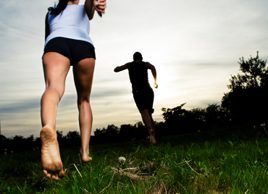Barefoot running: Should you ditch your shoes?
So-called ‘barefoot’ shoes are increasing in popularity, but is running barefoot (or almost barefoot) really better for your feet?

Source: Web exclusive, March 2011
Maybe you’ve seen them, flopping down the street, feet slapping strangely like a duck across the concrete. Or perhaps you’ve spotted them delicately treading through the aisles of the supermarket, carefully inspecting the ingredients on a box of cereal, toes wriggling in thought. And you probably thought to yourself: what on earth are those people wearing?
With the hope of achieving better foot health and strength, some hikers, runners and even weekend strollers are turning to ‘barefoot’ shoes like the Vibram Five Fingers‘essentially gloves for your feet’and other slightly more conventional looking ‘barefoot’ shoes designed to have the thinnest soles and least amount of support possible, such as the Nike Free and Vivo Barefoot ranges.
‘You get a lot of people pushing these shoes [based] on their personal experiences’some people are absolute devotees. For fifty years we’ve constantly seen the barefoot trend come and go in various forms,’ says John Gray, a kinesiologist based in Toronto. ‘Various shoe companies capitalise on that because it sells shoes.”
All minimal and barefoot shoes are based on the same basic idea: humans evolved hundreds of thousands of years before shoes came along, so naturally it seems that it must be more healthy and natural for the muscles, ligaments and bones in our feet to tread without them. Overly constraining the natural motion of the foot, so the reasoning goes, prevents it from working optimally. So shoes can be blamed for foot injuries from fallen feet in children to plantar fasciitis in runners, say proponents of ‘barefooting’ as it is called. Some barefoot devotees take the idea even further, believing it philosophically better for the soul by removing the barrier between us and nature.
Is running without shoes safe?
There is certainly anecdotal evidence that humans can and do capably walk and run without shoes, an idea popularised in the west when Ethiopia’s Abebe Bikila set the world record in the marathon at the Olympics in Rome in 1960 without shoes. Many runners from African today prefer to run without shoes, and the Tarahumara Indians in the US run 100-kilometre races barefoot, or with just a thin layer of tire rubber strapped to their feet.
Some academic research indicates that barefoot treading puts less stress and strain on the feet, resulting in a lowered risk of injury. The most notable theory comes from evolutionary biologist Professor Daniel Lieberman at Harvard, who contends that barefooters suffer fewer injuries because of the way the foot hits the ground when it’s not protected by a shoe. People who run barefoot naturally strike the ground with their toes or ball of the foot first. Landing heel first is painful and we all avoid doing so if running barefoot.
‘Contacting the ground with the heel first’called a ‘heel crash”is associated with many of the typical lower extremity injuries often seen in running,’ Gray agrees. ‘However, what most people don’t realize is that although running comes naturally, there is a specific technique to do it properly by contacting the ground using the forefoot instead of the heel, directly under the hips instead of in front of the body. This will avoid a lot of the issues that are associated with running that shoes are blamed for.’
And there is no reason we can’t stride this way in shoes. Research at the Running Injury Clinic at the University of Calgary suggests that while there is ample evidence that striking forefoot first changes the mechanics of the foot, there is no research to directly prove or disprove the concept that explicitly running barefoot reduces injuries, as opposed to landing forefoot first in shoes.
Don’t ditch those shoes just yet
Apart from potentially being denied service in your local convenience store, ‘there are many good reasons to wear shoes,’ says Gray. Aside from the protection they afford from broken glass, doggy doo and other urban hazards, footwear provides support that some people genuinely need. ‘Yes, they constrain the foot, but for some people that is actually necessary,’ he says. Gray adds that while some of his patients who have adopted the barefoot shoe have seen an improvement in foot strength, others see no change and some peoples’ foot conditions actually worsen.
‘If you have flat feet, barefoot shoes won’t help’you need to work with a rehabilitation specialist who will actually help you retrain the foot in order to maintain the medial or the longitudinal arch,’ he explains. ”The bottom line is that you just can’t definitively say that one solution will be good for absolutely everybody.’
So are barefoot shoes right for you? The best answer will come from a physiotherapist, kineseologist or physician who understands your personal foot conditions.
Don’t miss out! Sign up for our free weekly newsletters and get nutritious recipes, healthy weight-loss tips, easy ways to stay in shape and all the health news you need, delivered straight to your inbox.




